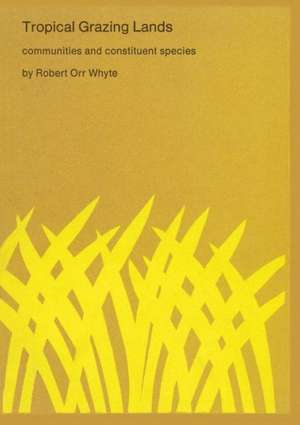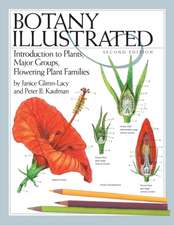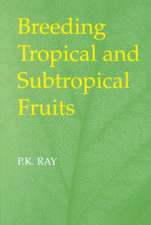Tropical Grazing Lands: Communities and Constituent Species
Autor R.O. Whyteen Limba Engleză Paperback – 30 iun 1974
Preț: 646.43 lei
Preț vechi: 760.50 lei
-15% Nou
Puncte Express: 970
Preț estimativ în valută:
123.69€ • 129.51$ • 102.60£
123.69€ • 129.51$ • 102.60£
Carte tipărită la comandă
Livrare economică 10-24 aprilie
Preluare comenzi: 021 569.72.76
Specificații
ISBN-13: 9789061930204
ISBN-10: 9061930200
Pagini: 240
Ilustrații: 222 p.
Dimensiuni: 210 x 297 x 13 mm
Greutate: 0.59 kg
Ediția:Softcover reprint of the original 1st ed. 1974
Editura: SPRINGER NETHERLANDS
Colecția Springer
Locul publicării:Dordrecht, Netherlands
ISBN-10: 9061930200
Pagini: 240
Ilustrații: 222 p.
Dimensiuni: 210 x 297 x 13 mm
Greutate: 0.59 kg
Ediția:Softcover reprint of the original 1st ed. 1974
Editura: SPRINGER NETHERLANDS
Colecția Springer
Locul publicării:Dordrecht, Netherlands
Public țintă
ResearchCuprins
of Chapters.- 1 Introduction.- 1.1 Objective and scope.- 1.2 Management of tropical grazing lands.- 1.3 Semantics.- 1.4 Succession and climax.- 1.5 Socio-economic factors.- 1.6 Ecosystems.- 1.7 Wildlife in African ecosystems.- 1.8 Coverage.- 1.9 Contrasts between tropical and temperate latitudes.- 2 Evolution of grass covers: Australia and Asia.- 2.1 Technique of ecological/historical analysis.- 2.2 Australia.- 2.3 Eastern monsoon Asia.- 2.4 Mainland and insular south-east Asia.- 2.5 Western monsoon Asia.- 3 Evolution of grass covers: Africa and America.- 3.1 Africa south of the Sahara.- 3.2 America: South, Central and Caribbean.- 4 Surrey and Assessment of Resources.- 4.1 The integrated or holistic approach.- 4.2 Significance of climate.- 4.3 Aerial photography.- 4.4 United Nations Programmes.- 4.5 The approach of the plant sociologist.- 4.6 Review of international literature.- 4.7 Range condition analysis.- 4.8 Grassland Survey of India.- 4.9 IEMVT, Maisons Alfort, France.- 4.10 Assessment in terms of livestock production.- 5 Synecology and Succession.- 5.1 Percentage of land under extensive and intensive use.- 5.2 Grass covers in forest climaxes.- 5.3 Authenticity of indigenous species.- 5.4 Relative aggression.- 5.5 Relative place in succession.- 5.6 The pantropical ubiquitaries.- 5.7 Indicator value.- 5.8 Types of grass covers.- 5.9 Succession in time and place.- 5.10 America: Caribbean Islands: Succession on abandoned cultivated land.- 6 Ecological Management of Natural Resources.- 6.1 Science and practice of management.- 6.2 Levels of production.- 6.3 Management on basis of condition analysis.- 6.4 The ecological component in range management.- 6.5 Prevention of progression to forest.- 6.6 Forestry working plan.- 6.7 Shrubs and trees in tropical grazing lands.- 6.8 The sylvo-pastoral system.- 7 Addition of Legumes to Sward.- 8 Replacement of Natural Covers.- 8.1 Small proportion of total area.- 8.2 Human sociological distinctions.- 8.3 Changed conditions of soil and habitat.- 8.4 Tailoring species for cultivation.- 9 The Gramineae.- 9.1 Importance.- 9.2 Origin.- 9.3 Taxonomy.- 9.4 Speciation.- 9.5 Taxonomic geography.- 9.6 Contributions to taxonomic geography.- 9.7 C. A. B. Bibliographies.- 10 The Leguminosae.- 10.1 Origin.- 10.2 Taxonomic geography.- 10.3 Legume/Rhizobium symbiosis.- 10.4 Fixation and transfer of nitrogen.- 10.5 Interest outside Australia.- 10.6 Research in Australia.- 10.7 C. A. B. Bibliographies.- 11 Genetic Evolution and Resources.- 11.1 Centres of origin.- 11.2 Reconciliation of species taxonomy and variability.- 11.3 Significance and use of variability.- 11.4 The Dichanthium complex.- 11.5 Reproduction and variability in species.- 11.6 Genetic resources.- 12 Plants and Environment.- 12.1 Autecology.- 12.2 Potential production and energy conversion.- 12.3 Photosynthesis.- 12.4 Root studies.- 12.5 Seasonality in growth.- 12.5.1 Seasonality in individual species.- 12.6 Flowering, reproduction and environment.- 12.7 Seed yield.- 12.8 Genetical response to physiological stress.- Addendum.- 13 Bibliography.- General.- Africa south of the Sahara.- America: South, Central, Caribbean.- Asia: Monsoonal and equatorial.- Australia and Pacific Islands.- 14 Index.- Subjects.- Geographical names.- Plant names.








